
Lycaena phlaeas, the small copper, American copper, or common copper, is a butterfly of the Lycaenids or gossamer-winged butterfly family. According to Guppy and Shepard (2001), its specific name phlaeas is said to be derived either from the Greek phlego, "to burn up" or from the Latin floreo, "to flourish".

The purple-shot copper is a butterfly in the family of the Lycaenidae or copper butterflies and in the genus of the Lycaena.

The scarce copper is a butterfly of the family Lycaenidae.

The purple-edged copper is a butterfly of the family Lycaenidae.
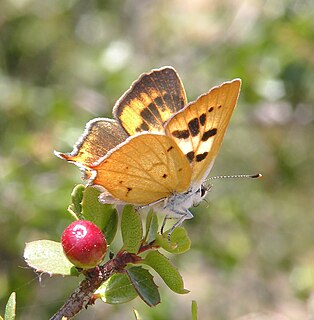
Lycaena hermes, the Hermes copper, is a species of butterfly in the family Lycaenidae. It is found in Mexico and southern California in the United States. It is known from a small number of areas. Forest fires in the San Diego area in 2003 and 2007 destroyed most of the populations.
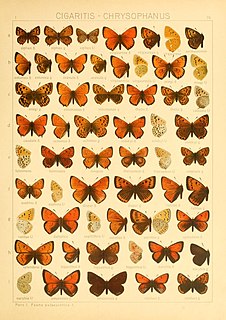
Lycaena ottomanus is a species of butterfly in the family Lycaenidae. It is found in Albania, Bosnia and Herzegovina, Bulgaria, Greece, Hungary, North Macedonia, Serbia and Montenegro, and Turkey. Its natural habitats are temperate forests and temperate shrubland. It is threatened by habitat loss.

Lycaena helle, the violet copper, is a butterfly of the family Lycaenidae. It is found from the Pyrenees to northern Norway and from Belgium east across the Palearctic to Central Asia, Siberia and Amur.The wingspan is 24–26 mm. The butterfly flies from May to July depending on the location.

Lycaena thersamon, the lesser fiery copper, is a butterfly of the family Lycaenidae. It is found from Eastern Europe, Italy and South-East Europe to Mongolia and North-Western China.
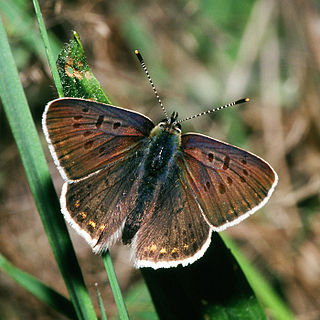
Lycaena tityrus, the sooty copper, is a butterfly of the family Lycaenidae. It is found in Europe.

Agriades optilete, the cranberry blue, is a butterfly of the family Lycaenidae. It is found in north eastern Europe, the Alps, North Asia, Japan, Korea and north western North America.

Lysandra albicans, the Spanish chalk-hill blue, is a butterfly of the family Lycaenidae. It is found in Spain and Western North Africa.
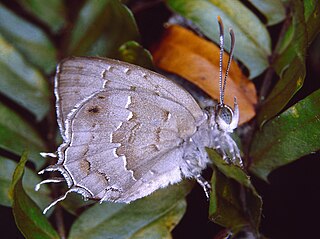
Surendra vivarna, the acacia blue, is a species of lycaenid or hairstreak butterfly found in Sri Lanka, India and the Indonesian islands as far as Sulawesi.

Lycaena dorcas is a species of butterfly in the family Lycaenidae, the gossamer-winged butterflies. Its common names include dorcas copper and cinquefoil copper. The species was first described by William Kirby in 1837. It is native to North America. The species L. dospassosi was once included in L. dorcas.

Lycaena epixanthe, the bog copper or cranberry-bog copper, is a North American butterfly in the family Lycaenidae. Adults like to sip drops of dew clinging to leaves and almost exclusively nectar on their host plant, cranberries. Because of this, bog coppers will spend their entire lives within the area of a single acid bog. Even though their flight is weak and close to the ground, bog coppers are hard to catch because of the habitat in which they live. Also, 85% of the bog coppers life span is spent in the egg. It is listed as a species of special concern in the US state of Connecticut.
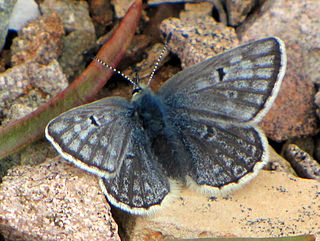
Agriades glandon, the Arctic blue or Glandon blue, is a species of butterfly in the family Lycaenidae. It in found in Eurasia and North America.

Polyommatus thersites, the Chapman's blue, is a butterfly in the family Lycaenidae. It is found in southern Europe, Morocco, Lebanon, Asia Minor, Iran and across the Palearctic to Siberia and Tian Shan.
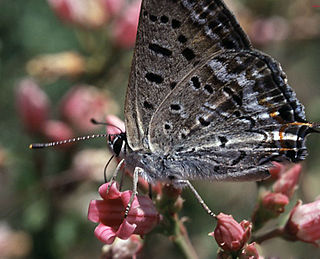
Lycaena arota, the tailed copper, is a butterfly of the family Lycaenidae. It is found in North America from New Mexico north and west to Oregon, south to southern California and Baja California, Mexico.

Polyommatus nivescens, the mother-of-pearl blue, is a species of butterfly in the family Lycaenidae. It is found in Spain. It is a small butterfly with a sexual dimorphism. The upperside of the male is very clear, with just a bluish beige reflection bordered by a thin grey line and a marginal line of small grey dots. The female upperside is brown, decorated with a marginal line of large orange maculae bordering the hindwings and part of the forewings. Both have a white fringe. The underside is light ochre marked with a marginal line of white lunules topped with orange, and adorned with a line of black dots circled in white very marked on the fore.

Lycaena boldenarum, the boulder copper, is a species of butterfly which is endemic to New Zealand, it is found on both North Island and South Island in a wide variety of open habitats including grassland, shingle and sand dunes. They are normally only active in bright sunny conditions and their flight is usually low to the ground. The boldenarum part of the species name given by the Scottish entomologist Adam White in honour of his first wife, Helen and her sister Frances, whose maiden name was Bolden. It shares the Maori name pepe para riki with two congeners the common copper and the glade copper.
Lycaena violacea is a small butterfly found in the Palearctic that belongs to the lycaenids or blues family.


















